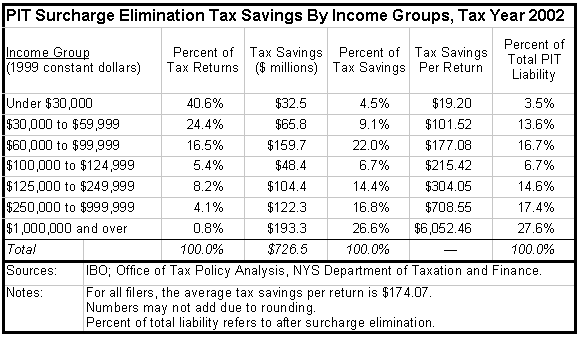Background. The surcharge equals 14 percent of the non-surcharge (or base rate) liability of city residents and accounts for 12.3 percent of total PIT liability. Initially established in tax year 1991 as a temporary measure that would expire in three years, the surcharge has been renewed several times. Without another renewal, the surcharge will expire on December 31, 2001. Renewing the surcharge would entail amending the state law that authorizes the surcharge, in addition to city legislative approval.
Timing and fiscal impact. The proposal initially published in the January financial plan calls for allowing the surcharge to expire on December 31, 2001 simply by not renewing it. If the surcharge is allowed to expire, fiscal year 2002 revenues would be reduced by $228 million. The full effect of eliminating the surcharge would be felt in the next two years, when PIT receipts would be reduced by $739 million in 2003 and $788 million in 2004.
In presenting the proposal to the City Council and the public, however, the Mayor called for enacting legislation that would eliminate the surcharge as soon as possible, which would hasten the fiscal impact. If surcharge elimination were to take effect in July, at the beginning of the city's new fiscal year, PIT revenue in 2001 would fall by approximately $700 million.
Beneficiaries of surcharge elimination. Surcharge elimination would generally reduce the tax burden of New Yorkers; only those city residents too poor to incur any city liability in the first place would not see a reduction in their income taxes. For tax year 2002, the first year after the surcharge will expire under current law, taxpayers on average would receive a $174 cut. But the bulk of the tax savings would be enjoyed by upper-income filers who constitute a minority of New Yorkers. This is because the benefits of surcharge elimination are proportional to the current distribution of PIT liability by income, and that distribution itself is skewed toward a small number of the most affluent because income distribution in New York is particularly unequal. (A forthcoming IBO fiscal brief will examine these issues.)
Using the latest available sample of tax returns plus our income projections, IBO has modeled the distribution of tax savings across different income groups that would result from surcharge elimination. Taxpayers with annual incomes of $125,000 or more are expected to account for 13.1 percent of all returns filed for tax year 2002, but they would receive well over half- 57.8 percent-of the projected $726.5 million in tax savings for the year. The percent of the tax savings received by this group is similar to its percent share of PIT liability (59.4 percent with the surcharge and 59.6 percent without).
The concentration of tax liability and tax savings is especially striking when one looks at the less than 1 percent of returns reporting incomes of $1 million or more. The taxpayers filing these returns would receive 26.6 percent of the tax savings and account for 27.6 percent of tax liability. Surcharge elimination would reduce these taxpayers' PIT liability by an average of $6,052 per return, compared with $174 per return for all filers.
The distribution of the tax savings that resulted from the 1998 expiration of the 12.5 percent PIT surcharge, which had been largely dedicated to criminal justice programs, was similarly concentrated among the wealthiest New Yorkers. When the proposal to let the 12.5 percent surcharge expire was initially made by the City Council Speaker, it was coupled with a proposal to make the schedule of PIT base rates more progressive-that is, to increase the degree to which marginal tax rates are higher in high-income brackets-in order to distribute the resulting tax savings more evenly among taxpayers of different income levels. However, the 12.5 percent surcharge expired without base rate restructuring. Thus far, the current proposal to eliminate the 14 percent surcharge has not been linked to any further changes in PIT rates that would significantly alter the distribution of the benefits.
For more information about this issue, please contact Michael Jacobs, a Senior Economist, at (212) 442-0597.
